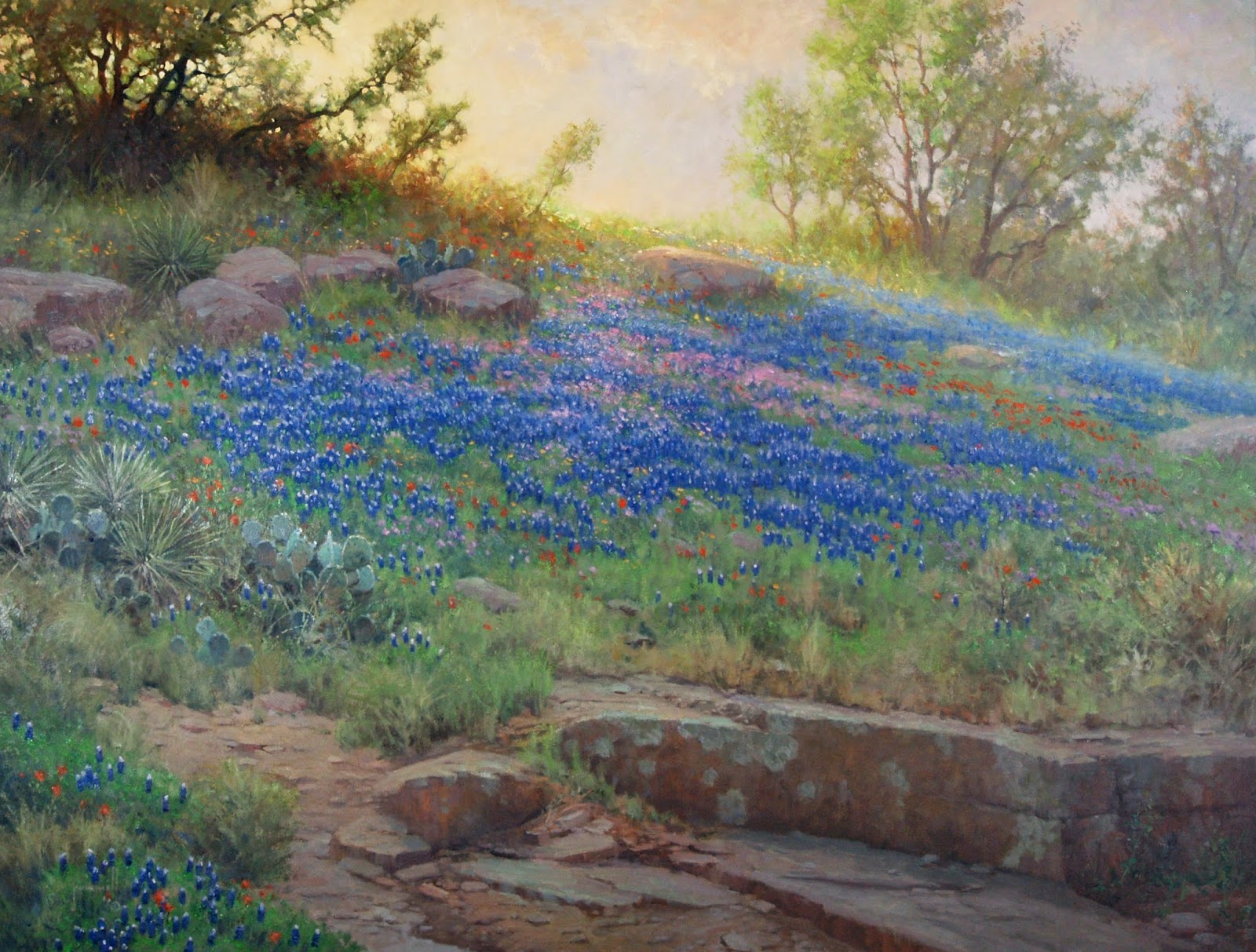The post below is adapted from "Texas; The Land and The Legacy, The Art of Bob Pummill by Michael Duty," which will be published later this spring.
 |
| A Spring Day in the Hill Country All paintings pictured are by Bob Pummill and all photos are courtesy of the artist. |
 |
| Prickly Pear Autumn |
In recent years, Bob Pummill has devoted much of his studio time to scenes of this type. Like his historic subjects that chronicle the history of the American West, Bob approaches the central Texas landscape (literally located just steps from his home) with imagination and varying perspectives. The land itself affords ample inspiration for artistic exploration. As Pummill has pointed out, Texas may not have the towering peaks of the Rockies or the Tetons, the magnificent vista of the Grand Canyon, or the fantastic shapes and colors of Yellowstone and Yosemite, but it does have the Hill Country. And while this area located to the north and west of Austin and San Antonio, may not be able to rival those locations for sheer dramatic panoramas, it does have a compelling and beautiful terrain full of hills, limestone and granite outcroppings, clear running streams, and of course, in early and mid Spring, fields of wildflowers that cover the ground like a carpet.
 |
| Sunlight and Shadow |
The Hill Country is a sort of geographic and geological transition point in the Texas landscape. It connects the low lands of the Gulf Coast and the black land prairies of East Texas to the high plains of West Texas and the cap rock of the Panhandle. Some historians and geologists have noted that the Hill Country serves as a dividing line, both geographically and culturally between the east and the west. To the east of the Hill Country, Texas history centers on southern traditions—the development of large cotton fields and lumber operations. To the west, Texas history focuses on ranching and cattle drives, frontier forts and Indian raids. Much of that divide is still evident today.
 |
| April in the Lone Star State |
However, artists did gradually make their way to the new state of Texas in the 1850’s. Most settled in San Antonio, which was rapidly becoming the state’s commercial and cultural center. The artists who established studios in and around San Antonio, such as Theodore Gentilz and Herman Lungkwitz, frequently made excursions to paint the countryside. Lungkwitz, in fact, established a home and studio in the Hill Country village of Fredericksburg, only a short distance from Bob Pummill’s present Kerrville studio.
Like Pummill, those early artists were captivated with the natural beauty of the area which offered an almost endless variety of scenery to capture. By the early twentieth century, through the talents and efforts of such artists as Julian Onderdonk, Dawson Dawson-Watson, Robert Wood, and Porfirio Salinas, a tradition of painting the central Texas landscape was firmly established. Each of those artists has added his own unique twist to picturing the Texas Hill Country.
 |
| Morning Blues |
 |
| First Bloom |
In recent years, both the market for early Texas art and the critical establishment have increasingly given greater credit to these early Texas artists. Onderdonk, in particular,has enjoyed very robust sales on the auction market. His work was also the subject of a major museum retrospective in recent years.
While Onderdonk perhaps set the gold standard for early landscape painting inTexas, other accomplished artists have added to that rich tradition. San Antonio oil wildcatter, Edgar B. Davis, established a lucrative cash prize for an annual competition for wildflower paintings in the late 1920’s. The prize attracted a talented group of artists who came to the Hill Country to try their hand at capturing the beauty of the landscape there. Many of those artists established studios in San Antonio, which further added to that city's reputation as an art center. In effect, the Texas Hill Country, played a direct role in establishing an artistic heritage in the state. |
| Near Llano |
Bob Pummill's recent landscape paintings are a fitting complement to the work of those early artists. His work furthers the tradition they established, but also adds a new dimension to the larger body of work devoted to the Texas landscape.
 |
| Wildflowers and Granite |
His subject matter is similar to that of the earlier artists, but he brings his own unique perspective and style to those scenes. For example, "Summer Lace," presents a subject that might have easily been selected by Wood, Salinas, or Dawson-Watson, or even Onderdonk, but it is done in a manner radically different from any of those artists. Here the focus is on the close up elements of the land--tall grasses, yucca, and cactus.
The distant horizon is really not seen at all, obscured by the dense foliage and live oak trees. The interplay between the cool shadows, which dominate most of the canvas, and the fading light of day, shown here as a shaft of sunlight that divides the canvas, is done so in a subtle, and nuanced manner. The light shines through the branches of a large Live Oak that anchors the right side of the painting and adds just enough highlight to catch and hold the viewer's attention. The overall effect is a sense of quiet, tranquility, a timeless moment that allows one to reflect on the beauty of nature even in the simplest and most commonplace scenes.
 |
| Summer Lace |
“Texas, the Land and the Legacy: The Art of Bob Pummill "is the second collaboration between the artist and writer. Their first book together, "Under Western Skies: The Art of Bob Pummill" was published in 2002.



